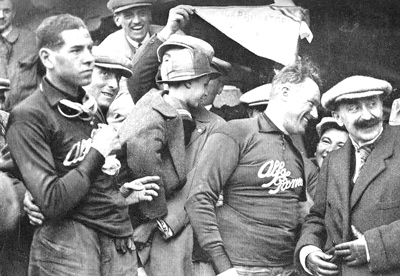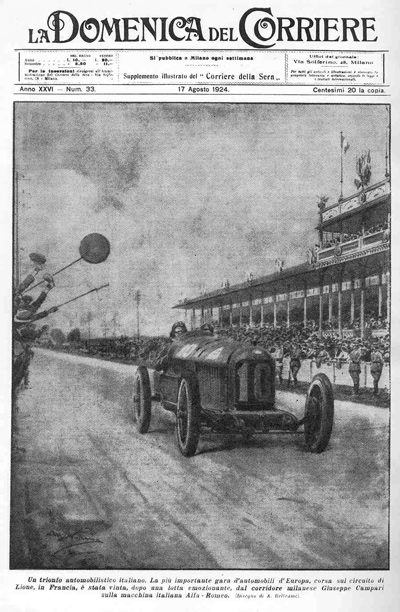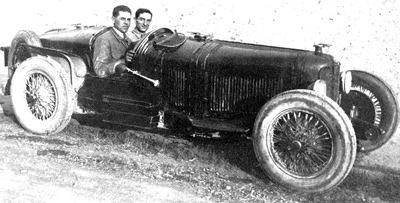October 10th, 2007
The Anglo-Italian Saga of Giulio Ramponi
Part I

From left to right: Ramponi, Alberto Ascari as a child, his father Antonio, and Nicola Romeo at the 1924 Italian Grand Prix. Credit: B.A, Alridge.
|
Story by Nicholas Lancaster
Giulio Ramponi was born in Milan on 8 January 1902. His father died while he was still a small boy and a stepfather also died young. From an early age Giulio showed an aptitude in mechanical matters and took a technical course at the Arti e Mestieri school in via Santa Maria. From there he went to work for the Florentia car company before a brief stint at the Pelizzola fuel pump company in 1919.
At Pelizzola he attracted the attention of Giuseppe Campari who was looking for a riding mechanic for the imminent Parma-Poggio di Berceto hill climb. Campari was already well known as a driver for Alfa Romeo, but we don�t know quite what he saw in the young apprentice. Perhaps it was merely that Giulio was enthusiastic and being still very young was notably slim in build � an important qualification for anyone sharing the cockpit with the bulky Campari.
So the young Ramponi joined Alfa Romeo in midyear as an apprentice with the exciting sideline of acting as riding mechanic to one of Italy�s leading drivers. It was a relationship that would soon produce undreamt of results.
At Alfa Romeo, Giulio received a splendid education as he passed through first the engine test section, then spent six months on running gear assembly. He then joined the experimental department run by Luigi Bazzi. At the same time, Giulio received driving lessons from none other than Attilio Marinoni, the company�s chief test driver. It was a fabulous all-round education in high performance automobile engineering.
In 1923 the legendary designer Vittorio Jano arrived on the scene, having been lured from Fiat to design a new racing car for Alfa Romeo. The young Ramponi was now well versed in all aspects of the company�s business and soon became involved in the ambitious competition program that resulted in the world beating P2 Grand Prix car.
Meanwhile Giulio�s own competition experience had been mixed with several retirements followed by a string of good results alongside drivers such as Campari, Antonio Ascari, and a certain Enzo Ferrari.
By 1924 the new P2 model was ready to enter the world stage and Giulio was chosen to take charge of Antonio Ascari�s car. As a warm-up the pair were entered in the Targa Florio, on the 27 April, in one of the older RL Targas. The pair were heading for victory, with a comfortable lead over Werner's Mercedes, when the engine seized within sight of the finish. Ascari and Giulio immediately leapt out and struggled with the starting handle, but to no avail. They began to push the car to the line, assisted by several soldiers and spectators, but as the clock ticked away they slipped to second place behind Werner. Unfortunately a protest was made � on the grounds that only the crew were allowed to push their car � and this was upheld by the stewards. The Alfa Romeo was disqualified and second place was given to Masetti in an RLTF Alfa.
Their next outing together was the French Grand Prix at Lyon, the debut of the P2 at the highest level. Ascari had already won the Circuito di Cremona on the car�s public debut, but on that occasion Luigi Bazzi had occupied the mechanic�s seat. In France, Giulio reclaimed his place alongside Ascari, but unfortunately for both of them the P2 failed, within sight of victory, on the thirty-second lap. Ascari managed to reach the pits where Giulio changed the plugs and added water to the radiator. Both men then tried desperately to re-start the engine on the handle, in a scene that must have brought back uncomfortable memories of the Targa Florio. But the cylinder headed was cracked and despite an attempt at a push start by the exhausted Ramponi, their race was over and the pair had to stand by and watch as Campari claimed the first major victory for the P2.
Alfa Romeo missed the next Grand Prix in Spain in order to concentrate on the following event, the Gran Premio d�Italia, and this time there was no need for Giulio to resort to pushing as the Ascari/Ramponi P2 ran out to victory, although the celebrations were somewhat muted due to the death of the well-known Brooklands driver, Count Zborowski, in a Mercedes Benz.

Italian newspaper reports of the Alfa Romeo P2 victory at Lyons in 1924; the team of Ascari and Ramponi retired while in the lead.
|
A rule change for 1925 banned the use of riding mechanics during Grand Prix races. It was a change that probably saved Giulio�s life. He remained in charge of the preparation of Ascari�s car but was stationed safely in the pits when disaster struck in the French Grand Prix. Trying hard on a wet track, Ascari left the road and was mortally injured. At the funeral, Giulio � who had lost two fathers � was seen comforting Ascari�s son Alberto, who would later go on to become Italy�s only two time World Champion driver.
Despite this tragedy, life continued and for the Gran Premio d�Italia at Monza Giulio was looking after the car of the American Peter de Paolo but at the end of the season the Alfa Romeo team withdrew from Grand Prix racing and Giulio�s career took another path which would eventually place him in the driving seat.
Whilst continuing to work in the racing department, Giulio�s career took another step forward when he was assigned to the important role of chief test driver for the new 6c1500 project. Working directly under Jano this invaluable experience led to Giulio�s own competition debut behind the wheel of an early 1500 in the Cuneo�Maddalena hillclimb in August 1927. Having received instructions to take care and make sure that he finished, from none other than Jano himself, Giulio came home in third place over the 42 mile event.
Further outings behind the wheel in minor events were to follow but in 1927 a new event based in Brescia was unveiled that would change the face of competition motoring in Italy. The Mille Miglia was a 1000 mile road race around half of Italy and it immediately attracted impressive support from the Italian motor industry.
For the first race Alfa Romeo perhaps doubted the staying power of the new 6c1500 design and relied on the big, Merosi designed, RLSS models. Most people considered them the favourites for the race. Giulio took part as riding mechanic to his mentor, Marinoni, but their challenge ended in sight of the finish due to transmission failure in a disappointing event for Alfa Romeo that saw all of their leading cars run into problems.
For the following year the factory was determined to do better and Giulio was chosen as riding mechanic to Campari in the Alfa factory�s lead entry, the first of the supercharged 1500 models. This time the Campari/Ramponi team ran out as winners over strong OM and Lancia opposition, leading the first OM home by around fourteen minutes. The following year the duo repeated the formula, this time coming home in first place ahead of an OM by a mere 8 minutes � after a race that lasted 18 hours!

The 1924 P2 was a eight cylinder DOHC 2 liter. Here Ramponi sits behind the wheel of a P2 in with sports car modifications.
|
Meanwhile Giulio�s own career as a racing driver had taken off in spectacular fashion in another country, far to the north, where the Alfa Romeo marque was as yet little known.
In the early 1920�s the British Alfa Romeo importer, F. W. Stiles, was keen to build on the marque�s growing competition reputation. The introduction of the Jano designed 1500, and the success of Campari and Ramponi in the 1928 Mille Miglia, encouraged Styles to enter a team of 1500s in the 1928 Essex Motor Club Six Hour Race at Brooklands, one of the first long-distance races held in the country. This was the ideal opportunity to demonstrate the Alfa Romeo attributes of speed and endurance to a British audience, so two cars were entered, a supercharged 1500MMS for Giulio and a non-supercharged version for Carlo Bruno.
The race was run on handicap, based on engine size, and the 1500 Alfas proved to be the class of the field. While the fastest Bentley averaged 72.27 mph to cover 433.64 miles Giulio wasn�t far behind over the six hours, covering 417.44 miles at 69.51 mph. According to S.C.H. �Sammy� Davis, Sports Editor of �The Autocar�: �Ramponi�s pace was relatively much faster than most of the other cars, forcing the engines of rival cars to be pushed more than they liked.� The handicap formula certainly worked in Alfa Romeo�s favour, but it was an outstanding drive and Giulio received the Essex Cup for best performance, whilst also easily winning the 1.5 litre class from Bruno in the second Alfa.
Next week: Ramponi creates the Seaman Delage.
VeloceToday References:
The Alfa Romeo Tradition, book review
Four Great Alfa Designers
Articles on or about Alfa Romeo



